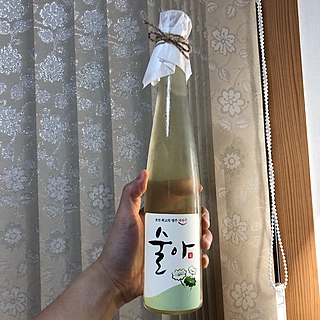
Korean cuisine has evolved through centuries of social and political change. Originating from ancient agricultural and nomadic traditions in Korea and southern Manchuria, Korean cuisine reflects a complex interaction of the natural environment and different cultural trends.

Korean royal court cuisine was the style of cookery within Korean cuisine traditionally consumed at the court of the Joseon Dynasty, which ruled Korea from 1392 to 1897. There has been a revival of this cookery style in the 21st century. It is said that twelve dishes should be served along with rice and soup, with most dishes served in bangjja (bronzeware).

Korean cuisine has a wide variety of traditional alcoholic drinks, known as sul (술). Many of these drinks end with the Sino-Korean word -ju, and some end with the native Korean word -sul. The Sino-Korean -ju is not used as an independent noun.

Barley tea is a roasted-grain-based infusion made from barley. It is a staple across many East Asian countries such as China, Japan, and Korea. It has a toasty, bitter flavor.

Oksusu-cha (옥수수차) or corn tea is a Korean tea made from corn. While oksusu-suyeom-cha (옥수수수염차) or corn silk tea refers to the tea made from corn silk, oksusu-cha can be made from corn kernels, corn silk, or a combination of both. The caffeine-free infusion is a popular hot drink in winter. Along with bori-cha, oksusu-cha is one of the free grain teas served in many restaurants in place of water.

Sujeonggwa (Korean: 수정과) is a Korean traditional cinnamon punch. Dark reddish brown in color, it is made from mainly cinnamon, sugar, water and ginger. It's often served with gotgam and garnished with pine nuts. The punch is made by brewing first the cinnamon sticks and ginger at a slow boil. The solids are then removed for clarification and the remaining liquid is boiled again after adding either honey or brown sugar. The dried persimmons are cut into portions and are added to soak and soften after the brew has completely cooled. This is usually done several hours before serving, as extensive soaking of the fruit may thicken the clear liquid to a murky appearance.

Sikhye is a traditional sweet Korean rice beverage, usually served as a dessert. It is a popular beverage in South Korea, often found in the beverage sections of convenience stores. It is a drink made by fermenting rice with malt to give it a sweet taste. In addition to its liquid ingredients, sikhye contains grains of cooked rice and in some cases pine nuts. It is similar to the Chinese jiuniang and Japanese amazake.

Sungnyung (Korean: 숭늉) is a traditional Korean infusion made from boiled scorched rice.

Baesuk is a variety of hwachae, Korean traditional fruit punch made with bae, black peppercorns, ginger, honey or sugar, and water.
Yuja-hwachae is a variety of hwachae, Korean traditional fruit punch made with finely shredded yuja, Korean pear, and honey or sugar. In Korea, yuja are largely cultivated in the southern part of the Korean peninsula such as Goheung and Wando, Geoje, and Namhae. Therefore, yuja hwachae has been a local specialty of the Jeolla Province and Gyeongsang Province.

Jeho-tang is a traditional Korean cold drink made with honey and several ingredients used in traditional Korean medicine. The ingredients include omae, sain, baekdanhyang, and chogwa. The powdered ingredients are mixed together with honey and water and then boiled. After the liquid is chilled, it is diluted in cold water. It was considered the best summer drink in Korean royal court cuisine.
Sudan is a traditional Korean punch made with boiled grain cake balls and honeyed water. It is usually served during the summer for quenching thirst. Traditionally Sudan was always served during a village rite in the 6th month of the Korean calendar (lunar). Korean farmers prayed for a bountiful harvest and god's blessing for their life in the future by making food offering including foods and Sudan drink. It is sometimes considered a type of hwachae.

Gwaha-ju is a traditional Korean fortified rice wine. The refined rice wine cheongju is fortified by adding the distilled spirit soju to produce gwaha-ju. Popular varieties include gangha-ju (강하주) of Boseong and Yeonggwang in South Jeolla Province, sinseon-ju (신선주) of Namwon in North Jeolla Province, and yak-soju (약소주) of Suwon in Gyeonggi Province.













